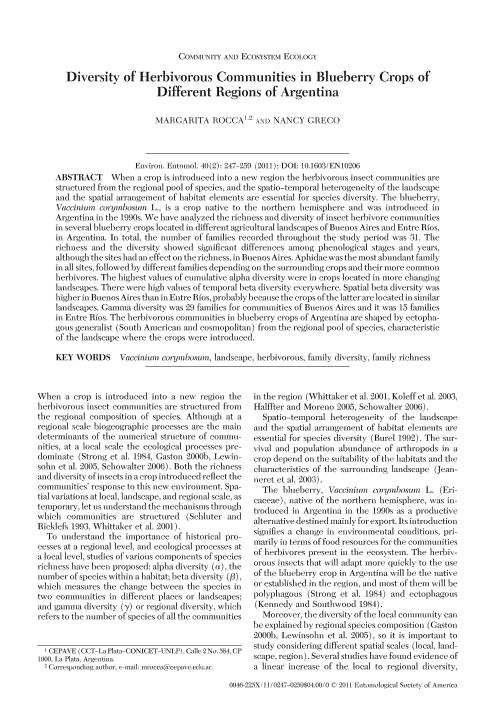Artículo
Diversity of Herbivorous Communities in Blueberry Crops of Different Regions of Argentina
Fecha de publicación:
04/2011
Editorial:
Entomological Society of America
Revista:
Environmental Entomology
ISSN:
0046-225X
Idioma:
Inglés
Tipo de recurso:
Artículo publicado
Clasificación temática:
Resumen
When a crop is introduced into a new region the herbivorous insect communities are structured from the regional pool of species, and the spatio-temporal heterogeneity of the landscape and the spatial arrangement of habitat elements are essential for species diversity. The blueberry, Vaccinium corymbosum L., is a crop native to the northern hemisphere and was introduced in Argentina in the 1990s. We have analyzed the richness and diversity of insect herbivore communities in several blueberry crops located in different agricultural landscapes of Buenos Aires and Entre Ríos, in Argentina. In total, the number of families recorded throughout the study period was 31. The richness and the diversity showed significant differences among phenological stages and years, although the sites had an effect on the richness, in Buenos Aires. Aphidae was the most abundant family in all sites, followed by different families depending on the surrounding crops and their more common herbivores. The highest values of cumulative alpha diversity were in crops located in more changing landscapes. There were high values of temporal beta diversity everywhere. Spatial beta diversity was higher in Buenos Aires than in Entre Ríos, probably because the crops of the latter are located in similar landscapes. Gamma diversity was 29 families for communities of Buenos Aires and it was 15 families in Entre Ríos. The herbivorous communities in blueberry crops of Argentina are shaped by ectophagous generalist (South American and cosmopolitan) from the regional pool of species, characteristic of the landscape where the crops were introduced.
Palabras clave:
Vaccinium corymbosum
,
landscape
,
herbivorous
,
family diversity
,
family richness
Archivos asociados
Licencia
Identificadores
Colecciones
Articulos(CEPAVE)
Articulos de CENTRO DE EST.PARASITOL.Y DE VECTORES (I)
Articulos de CENTRO DE EST.PARASITOL.Y DE VECTORES (I)
Citación
Rocca, Margarita; Greco, Nancy Mabel; Diversity of Herbivorous Communities in Blueberry Crops of
Different Regions of Argentina; Entomological Society of America; Environmental Entomology; 40; 2; 4-2011; 247-259
Compartir




